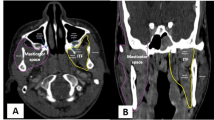Abstract
Background
For a long time, craniopharyngiomas have been considered surgically attractive tumours. The fact that they are rare, histologically benign, and located in a challenging (but considered accessible) area made them worthy surgical prizes.
Methods
As we have saved vision and “cured” many of these tumours, the insidious and devastating effects on quality of life for these children has become evident.
Discussion
The state-of-the-art in the surgical management of craniopharyngioma is now turning to multi-modality treatment strategies (combination surgery and radiotherapy) aiming to limit morbidity. Questions remain—what factors influence our surgical decision making? Do we understand the long-term effects of the radiotherapy now being employed? We review a series of craniopharyngiomas looking for variables that correlated with outcome as perceived in terms of quality of life and we review briefly the history of craniopharyngioma surgery and the relevant literature.

Similar content being viewed by others
References
Brauner R, Malandry F, Rappaport R, Pierre-Kahn A, Hirsch JF (1987) Craniopharyngiomes de l’enfant, A propos de 37 cas. Arch Fr Pediatr 44:765–769
Caldarelli M, Di Rocco C, Papacci F, Colosimo C Jr (1998) Management of recurrent craniopharyngioma. Acta Neurochir 140:447–454
Carpentieri SC, Waber DP, Scott RM, Goumnerova LC, Kieran MW, Cohen LE, Kim F, Billett AL, Tarbell NJ, Pomeroy SL (2001) Memory deficits among children with craniopharyngiomas. Neurosurgery 49 (5):1053–1058
Cavazzuti V, Fischer EG, Welch K, Belli JA, Winston KR (1983) Neurological and psychological sequelae following different treatments of craniopharyngioma in children. J Neurosurg 59:409–417
Choux M, Lena G, Genitori L (1991) Rapport de la société française de neurochirurgie, craniopharyngiomes de l’enfant. Neurochirurgie 37:Suppl 1
De Vile CJ, Grant DB, Kendall BE, Neville BGR, Stanhope R, Watkins KE, Hayward RD (1996) Management of childhood craniopharyngioma: can the morbidity of radical surgery be predicted? J Neurosurg 85:73–81
De Vile CJ, Grant DB, Hayward RD, Kendall BE, Neville BGR, Stanhope R (1996) Obesity in childhood craniopharyngioma: relation to post-operative hypothalamic damage shown by magnetic resonance imaging. J Clin Endocrinol 81:2734–2737
Epstein FJ, Handler MH (1994) Craniopharyngioma: the answer. Proc Symposium, New York, NY, December 17–19, 1993. Pediatr Neurosurg 21(Suppl 1):1–132
Fischer EG, Welch K, Shillito J Jr, Winston KR, Tarbell NJ (1990) Craniopharyngiomas in children. Long term effects of conservative surgical procedures combined with radiation therapy. J Neurosurg 73:534–540
Habrand J-L, Ganry O, Couanet D, Rouxel V, Levy-Piedbois C, Pierre-Kahn A, Kalifa C (1999) The role of radiation therapy in the management of craniopharyngioma: a 25-year experience and review of the literature. Int J Radiat Oncol Biol Phys 44:255–263
Hayward R (1999) The present and future management of childhood craniopharygioma. Childs Nerv Syst 15:764–769
Hetelekidis S, Barnes PD, Tao ML, Fischer EG, Schneider L, Scott RM, Tarbell NJ (1993) 20-year experience in childhood craniopharyngioma. Int J Radiat Oncol Biol Phys 27(2):189–195
Hoffman HJ, Hendrick EB, Humphreys RP, Buncic JR, Amstrong DL, Jenkin RDT (1977) Management of craniopharyngioma in children. J Neurosurg 47:218–227
Hoffman HJ, De Silva M, Humphreys RP, Drake JM, Smith ML, Blaser SI (1992) Aggressive surgical management of craniopharyngiomas in children. J Neurosurg 76:47–52
Honegger J, Buchfelder M, Fahlbusch R (1999) Surgical treatment of craniopharyngiomas: endocrinological results. J Neurosurg 90:251–257
Islas Cruz G, Vite Vargas JA, Hernandez Marin I, Aguirre Ramirez A, Tovar Rodriguez JM, Ayala Ruiz AR (2004) Craniopharyngioma and its impact upon human reproduction: analysis of 15 cases at the Hospital Juarez de Mexico. Ginecol Obstet Mex 72:345–348
Merchant TE, Kiehna EN, Sanford RA, Mulhern RK, Thompson SJ, Wilson MW, Lustig RH, Kun LE (2002) Craniopharyngioma: the St Jude Children’s Research Hospital experience. Int J Radiat Oncol Biol Phys 53:533–542
Muller HL, Gebhardt U, Etvard-Gorris N, Korenke E, Warmuth-Metz M, Kolb R, Sorensen N, Calaminus G (2004) Prognosis and sequela in patients with childhood craniopharyngioma—results of HIT-ENDO and update on KRANIOPHARYNGEOM 2000. Klin Padiatr 216(6):343–348
Pierre-Kahn A, Brauner R, Renier D, Sainte-Rose C, Gangemi MA, Rappaport R, Hirsch JF (1988) Traitement des craniopharyngiomes de l’enfant. Analyse rétrospectives de 50 observations. Arch Fr Pediatr 45:163–167
Pierre-Kahn A, Sainte-Rose C, Renier D (1994) Surgical approach to children with craniopharyngiomas and severely impaired vision: special considerations. Pediatr Neurosurg 21(Suppl 1):50–56
Poretti A, Grotzer MA, Ribi K, Schonle E, Boltshauser E (2004) Outcome of craniopharyngioma in children: long-term complications and quality of life. Dev Med Child Neurol 46(4):220–229
Rutka JT (2002) Craniopharyngioma. J Neurosurg 97:1–2
Takahashi H, Nakazawa S, Shimura T (1985) Evaluation of postoperative intratumoral injection of Bleomycin for craniopharyngioma in children. J Neurosurg 62:120–127
Villani RM, Tomei G, Bello L, Sganzerla E, Ambrosi B, Re T, Barilari MG (1997) Long-term results of treatment for craniopharyngioma in children. Childs Nerv Syst 13:397–405
Voges J, Sturm V, Lehrke R, Treuer H, Gauss C, Berthold F (1997) Cystic craniopharyngioma: long-term results after intracavitary irradiation with stereotactically applied colloidal beta-emitting radioactive sources. Neurosurgery 40(2):263–270
Yasargil MG, Curcic M, Kis M, Siegenthaler G, Teddy PJ, Roth P (1990) Total removal of craniopharyngiomas. Approach and long-term results in 144 patients. J Neurosurg 73:3–11
Author information
Authors and Affiliations
Corresponding author
Rights and permissions
About this article
Cite this article
Sainte-Rose, C., Puget, S., Wray, A. et al. Craniopharyngioma: the pendulum of surgical management. Childs Nerv Syst 21, 691–695 (2005). https://doi.org/10.1007/s00381-005-1209-2
Received:
Published:
Issue Date:
DOI: https://doi.org/10.1007/s00381-005-1209-2




